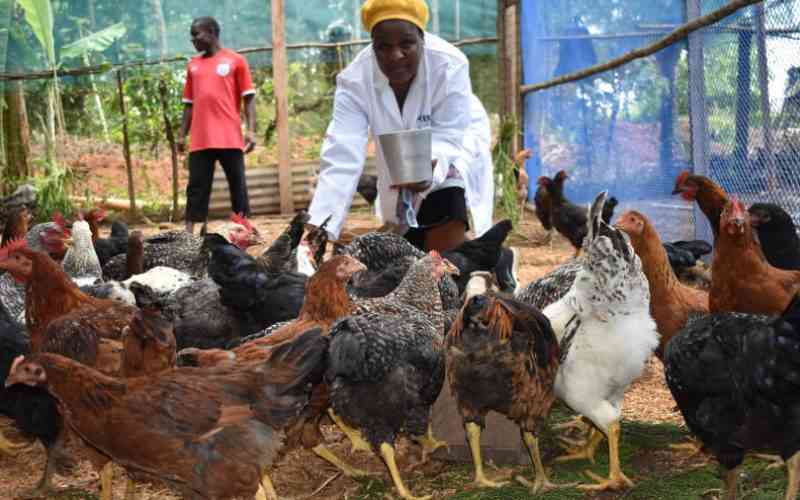
Jane Meja at her poultry farm in Shamiloli village in Shinyalu sub county feeding her birds [Mumo Munuve, Standard]
Greetings Dr Messo, I want to start a small improved kienyeji poultry farm for meat in Kisaju. Kindly advise on the process from the structures to the first chick through maturity. George.
Dear George, Thank you for your interest in poultry farming. There is a fast- growing middle-class and rapid urbanisation and these are driving change in the consumption pattern of our youth. More people are now changing from a predominantly vegetable diet (beans + chapati) to a protein rich diet like chicken. In the kienyeji poultry farming, more people are moving into a professional approach with improved innovations and technologies to uplift the industry and supply the eateries with kienyeji chicken. I see huge business potential in poultry markets around Kitengela, Mombasa Road, Athi River, Embakasi and its environs that you can exploit. Here are 5 key steps towards realisation of your dreams.
Housing
A suitable house should be provided regardless of the final product. Being in a tropical climate, I suggest an open sided rectangular unit to allow natural ventilation and built in an East-West orientation. Side wall should be 3 feet high and made of bricks or GI sheet, the rest of the wall should be covered by wire mesh to allow ventilation and keep off wild birds and rodents. Ensure stocking density of 1 bird per 1.5 square feet, having the right density will ensure proper space for the chickens which will guarantee better performance.
Biosecurity
To protect your flocks, fence off the unit with barbed wire and provide a lockable gate. Keep away unnecessary visitors and provide your workers with uniforms, boots and showering facilities. Provide a foot bath on the entrance and ensure you have rat bait stations around your flock unit.
Brooding and growing birds
Provide clean wood shavings in the units at 2-4 inches deep, fit curtains to help with temperature control in the units. Introduce charcoal stove, six hours before chick's arrival, mini drinkers and supplemental feeder trays at 1 tray for 100 chicks. Buy Kienyeji Unga starter feed and sprinkle or broadcast on a paper spread on the floor. Provide clean portable water all the time with multivitamins anti stress. Feed small amount more often to spur activity and weight gain. Introduce adult feeders and bell drinkers at two weeks. Keep brooder temperatures at 33-35 degrees in the first week and reduce by three degrees every week until week three when brooding is unnecessary. If you have a big compound, free range the birds during the day and provide feeds such as kitchen waste, grains like millet, sorghum, brewers mash and vegetable oil extract to give the birds yellow meat colour and natural taste.
Birds weighing
Weigh a sample of your birds every day during the growing period from the same site, at the same time of the day and record. A sample of 5 per cent of the total population is good to go. Depending on the type of breed you chose, the target weight should be 1.5kg live achieved in 7 weeks on high quality commercial broiler diet. The same weight can be achieved on minimal supplementation on broiler diet for the first three weeks and released on free range scavenging. The most common breeds are Kenbro, Kari and Kuroiler. Most hatcheries do not sell male chicks only because of challenges in gender sexing of these slow feathering birds.
Marketing
The common route to market this type of bird is through live sales in eateries and farm gate. Some farmers slaughter them on site, pack and sell through retail and butcheries. This industry is recognised as an economic activity with squeezed margins, where profit depends among other factors on scale of production, reduced overhead costs and high operation efficiencies. Good luck in your poultry journey.
 The Standard Group Plc is a multi-media organization with investments in media
platforms spanning newspaper print
operations, television, radio broadcasting, digital and online services. The
Standard Group is recognized as a
leading multi-media house in Kenya with a key influence in matters of national and
international interest.
The Standard Group Plc is a multi-media organization with investments in media
platforms spanning newspaper print
operations, television, radio broadcasting, digital and online services. The
Standard Group is recognized as a
leading multi-media house in Kenya with a key influence in matters of national and
international interest.



